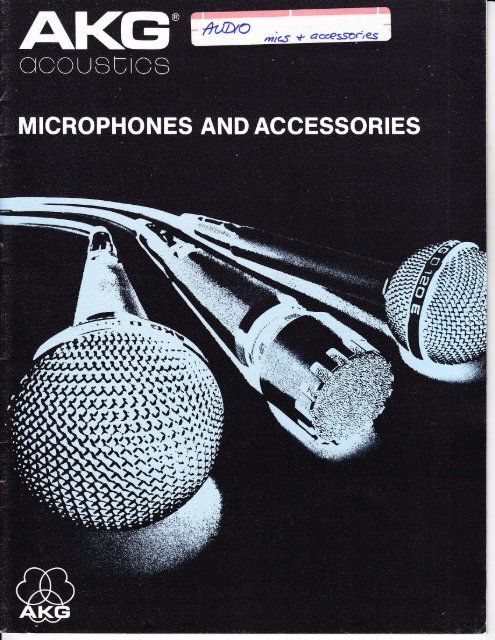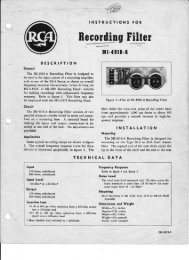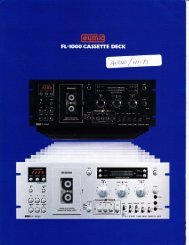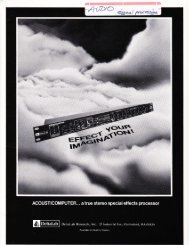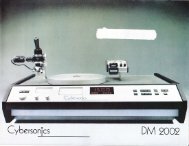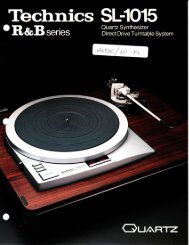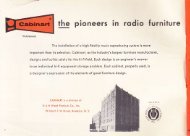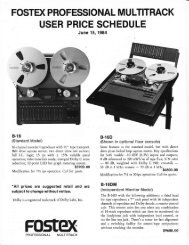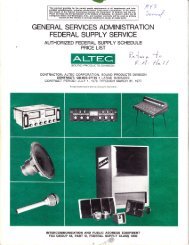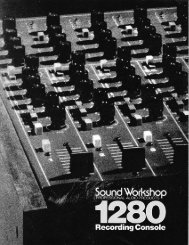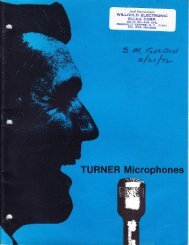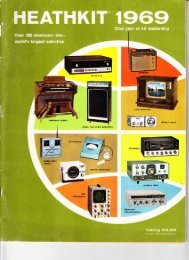AKG_Mics_1978_part1 - Preservation Sound
AKG_Mics_1978_part1 - Preservation Sound
AKG_Mics_1978_part1 - Preservation Sound
Create successful ePaper yourself
Turn your PDF publications into a flip-book with our unique Google optimized e-Paper software.
m;6 * accesSel4s<br />
=\-:l \<br />
t*'-::<br />
+}JJ,,<br />
rLfJ r. '<br />
'i\\y<br />
}i,:ll<br />
;1,.'rf,<br />
i*.:r<br />
i<br />
. ',1<br />
. . ir-!g<br />
\' ,'l<br />
E:.ir#<br />
\.i.'i<br />
#
lndividual specif ication sheets are available for<br />
all <strong>AKG</strong> microphones providing complete daft, cuMes,<br />
electrical and dimensional diagrams as wel/ as<br />
Architects & Engineers Specif ications.<br />
Table of Contents<br />
Page<br />
3. Introduction to <strong>AKG</strong><br />
4. Selecting a lvlicrophone<br />
5. Howto lnterpretTechnicalSpecifications<br />
8, C-500 Electret Condenser System<br />
10. C-500 Accessories & Power Supplies<br />
12. D-12 Cardioid Dynamic<br />
D-109 Lavalier Dynamic<br />
D-120E/ D-120ES Cardioid Dynamics<br />
D-130 Cardioid Dynamic<br />
'14. D-140E Cardioid Dynamic<br />
D-160E 1 Omnidirectional Dynamic<br />
D-170E Supercardioid Dynamic<br />
D- 190E/D- 190ES Cardioid Dynamics<br />
1 6. Dl000E Adjustable-Fiesponse Cardioid Dynamic<br />
D-2000E Ad j ustable-Response Supercardioid Dynamic<br />
1 8. D-190SPL/SPH & D-120SPL/SPH Stereo Pairs<br />
19. The Patented <strong>AKG</strong> Two-Way Syslem<br />
20, D-200E Two-Way Cardioid Dynamic<br />
21. Accessories-Windscreens, Stand Adapters,ShockSuspensions, e1c.<br />
22. KM Microphone Slands<br />
23, MCH Nilicrophone Cables
<strong>AKG</strong>...<br />
a name that has amassed an enviable world-wide reputation for<br />
performance, dependability and service. A microphone for every<br />
need. . . television studios, motion-picture production centers,<br />
theatres, stadiums, concert halls, opera houses, communication links,<br />
schools, home tape recorders. . .and the personal choice of hundreds<br />
of performers,<br />
Among professionals-the name <strong>AKG</strong> is synonymous with the<br />
highest standards in quality, performance, and dependability,<br />
Based on intensive scientif ic research, an extensive knowledge of<br />
acoustics and measurement techniques, design competences,<br />
preclsion tooling and meticulous manufacturing standards, <strong>AKG</strong> has<br />
achieved many f irsts in microphone development.<br />
ln the pastthree decades, <strong>AKG</strong> research has resulted in numerous<br />
signif icant acoustical developments, ref lected in over 600 worldwide<br />
patents held by <strong>AKG</strong>. Today, <strong>AKG</strong> operates one of the largest<br />
research facilities devoted exclusively to the development of new<br />
condenserand dynamic microphones, headphones,<br />
phonocarlridges and other related acoustic products. lt is staffed by<br />
over 40 scientists and engineers, who have al their disposal more than<br />
20 walk-in anechoic chambers complete with the latest acoustical,<br />
mechanical and electronic measuring equipment.<br />
Research and development is on-going, and new projects<br />
e.9., ultrasonic transducers, infrared and other wireless techniques,<br />
digital and analog delay lines, malerials analysis, artificial reverberation,<br />
phonocartridges, electret transducers, and more are under<br />
investigation. ManufacturinQ methodsare constantly updated.<br />
Product ruggedness and seryiceability are continually improved<br />
without compromising quality. <strong>AKG</strong> is proud to be in the forefront of<br />
newer and better sound reproduction.
Selecting a microphone<br />
When considering the purchase of a new microphone, a<br />
performer should weigh his needs careiully. Naturally, he will<br />
want a high-quality microphone wlth performance characteristics<br />
that have been designed for clean vocal projection,<br />
even under acoustically dlff icult conditions.<br />
Response should be smooth across the vocal frequency<br />
range, yet less sensitive to extraneous noises (air conditioner<br />
"rumble" and such) usually found ln lesslhan-ideal<br />
performance situations. And the microphone should be a<br />
rugged unit, specially designed to withsland rough, tough<br />
handling.<br />
Asthe professional peformer well knows, hls microphone is<br />
a musical instrument, a valuable tool that must respond<br />
freely to whatever vocal mood he desires to communicate<br />
to his audience at any moment. Properly used, it can<br />
effectively project hls "individuality" to his audlence.<br />
lt should respond smoothly to his control..<br />
. predictably to his demands. lt should<br />
provide a warm, intimale sound when the<br />
mood is right ... or sound off solidly to beat<br />
oJl hard rock materialwrthoul dislortion<br />
MoreoveI the microphone should have a<br />
creative flexibility that al ows the serious<br />
performer various options to control the<br />
sound...options that give him a 'nore n-<br />
noval.ve cortact witl- hrs aLdience dur']q<br />
live performances.<br />
lnousands ol recoros produceo every<br />
yea[ are recorded exclusively with <strong>AKG</strong> mi<br />
crophones. From Bach to Rock, <strong>AKG</strong> has helped 10 br ng<br />
some of the f inest sounds into your liv ng room. Sheff ield<br />
Lab has recently released "The King James Version" featurlng<br />
Harry James and His Big Band, recorded uslng the renowned<br />
C-24 stereo studio condenser microphone. lts<br />
realism is astounding. Numerous broadcasls, symphony<br />
orchestras, opera performances, musicals and dramatic<br />
theatre, outdoor concerts and many other live performances<br />
are staged with <strong>AKG</strong> microphones. To the discerning<br />
user, acoustic quality, dependability and<br />
serviceability are paramount critef a in the selection of <strong>AKG</strong><br />
microphones.
How to interpret<br />
microphone technical specifications.<br />
To help select the right microphone for a particular applicatron,<br />
most reputable microphone manufacturers publsh<br />
technica -performance data for each microphone n their<br />
product line. These data realy aren't as mystifying as they<br />
might seem at first glance. n fact, for purposes of match ng<br />
the microphone to the application, there are basica y only<br />
four distinctive things that you need to know about any microphone-<br />
ts directional characteristic, ils frequency<br />
range, ils sensitivity and ils impedance The following s a<br />
simple pr mer on each of these.<br />
Directional Characteristics<br />
Simply stated, a microphone's directiona characteristic is<br />
an rndication of how sensil ve or lnsensitive a microphone is<br />
to sounds directed at it from varlous d rections (ang es)-<br />
front (0'), sides (90') and rear (180'). t \\rill be demonstrated<br />
in the following paragraphs that different mlcrophones<br />
are intentonally designed to have dfferent<br />
dlrectional characteristics. Funhermore. each directonal<br />
characterstic can be expressed both by a generc name<br />
("omnid rectional," "cardioid;'etc.) and by a pictorial represenlation<br />
of its dislinctive pattern or shape (a two-d mensiona<br />
po ar response curve n most data sheets, or a three<br />
dimensiona representation as used in th s guide).<br />
response curve) is more discriminat ng than an omni'<br />
directional rn crophone. A cardioid microphone s most sensitive<br />
to sound directed loward its front (0'), with sensitvity<br />
progressively decreas ng as the sound-plckup angle moves<br />
to the rear (180'). For th s reason, cardioids are the pre<br />
ferred cho ce in both recordlng and live performances<br />
where audlence. "house" and other amb ent noises must<br />
be suppressed, where nstruments or voices musl be solated<br />
from others n the group or orchestra, or where aud to<br />
rium or room reverberation and feedback must be rejected.<br />
It is, in fac1, the cardiod's inherent res stance to feedback...the<br />
squealing, howling sound that occurs when an<br />
amplified slgnai s picked up again by the microphone and<br />
re-amplif ied. . .that makes this type of microphone a favor 1e<br />
among performers, espec ally when used in lesslhan- dea<br />
acoustic situat ons.<br />
Card old characterslics descr be an<br />
essentally un lorm pickup lrom the<br />
fronl ot the mcrophone and sup<br />
pression of lhe sound lromthe rear<br />
Omnidirectional<br />
An ornnidirect ona ("omni") microphone s equa y sensitive<br />
to sound d rected at it from a// directions and angles (a<br />
range of 360'). Consequently, omnidirectional mlcrophones<br />
are usua y reserved for recording and broadcasting<br />
in acoustically "good" locations-where background noise<br />
and acousticjeedback tendencies are not presenl. Under<br />
A m crophone with an omn drrectional<br />
or non drrectional pick-Ltp<br />
characl-drisTic has a rnform re,<br />
sponse over360'<br />
these condii ons, an omnidirectional microphone s an excelent<br />
choice for accentuating the acoustic "ambience" of<br />
a recording ste, for coverage of a "round-table" discusslon<br />
or for serving as a non discriminat ng interview m crophone.<br />
Cardioid<br />
A cardioid microphone (so ca ed because of its characteristically<br />
heart-shaped direct onal pattern on a polar<br />
Cardloid microphones are often incorrectly referred to as<br />
"unidirectonal" microphones. The term "unidirectona<br />
may be misleadlng. The lact is that cardioids do or, in fact<br />
should... reproduce sounds directed toward them lrom the<br />
s de. For effective reproducliof of smal groups for n<br />
stance, the microphone should p ck up not only sounds thal<br />
reach it trom the front, but from somewhal off-axis as we<br />
in addition to card oids, <strong>AKG</strong> designs and manufactures<br />
other-more specialized types of directiona mlcrophones<br />
such as, "shotgunsl"'supercardioidsl' etc. N4ore informa<br />
tion about these kinds of m crophones fo ow in the ndivid<br />
ual product descr ptions in this catalog.<br />
Frequency range<br />
For good music and/or voice reproduct on, a microphone<br />
should respond smooth y over the full spectrum of musica<br />
pitch and timbre-referred to as the audible f requency<br />
range. The frequency range of a m crophone, and how the<br />
rn crophone perlorms in particular ntervals within that<br />
range, wil determine whrch microphone you will select. Fre<br />
quency s the engineering term used to descrjbe musica<br />
pitch. (The h gher the frequency, the higher the pitch; the<br />
ower the frequency, the ower the pitch.) A luning fork os<br />
c I ating (v brating) at 440 t mes per second wil audibly re-
produce the musical note 'A above middle C"-lhe<br />
internalional tone for tuning any musical instrument. The<br />
number of vib,rations in a time period of one second necessary<br />
to reproduce a given pitch is referred to as cycles per<br />
second (cps), o[ more commonly, Herlz (Hz). Thus the frequency<br />
of the musical note 'A above middle C" ls said to be<br />
440 Hz.<br />
fhe frequency response of a mlcrophone is usually indicated<br />
(via a line graph) over the full audio spectrum to il<br />
lustrate the response characteristlcs of that microphone to<br />
various pitches.<br />
other conditions, could lead to "muddy" recording and/or<br />
sound transmlssion. lVany <strong>AKG</strong> cardioid mjcrophones<br />
therefore include swltchable bass rolloff, thus providlng the<br />
option of either using or neutralzing proximity effect as<br />
required.<br />
Cardioid microphones also have other frequency-related<br />
considerations. lt is, oi course, desirable to maintain the essential<br />
uniformity of the cardio d rejection pattern at a// frequencies.<br />
lmporta'']t. Ioo. is ll^at frequercy 'esponse renain<br />
Front{o back discrimination ind<br />
cates in dB, how much unwanted<br />
sound ornoise is being relecled fiom<br />
the rear overlhe lrequency €nge.<br />
uniform, regardless of source-to-microphone angle of incidence.<br />
This is quite diff icult in vew of the many acousiical<br />
and mechanical problems involved, and slight variations at<br />
the two extremes of frequency response may be<br />
acceptable.<br />
The top curve of the loilow ng illustral on is the actu al freqLrency<br />
response of a microphone measured ai a sound-lncidence<br />
angle ol 0', while the bottom curve represents a rneasuremenl<br />
ar I80'olla: s.<br />
ln the illustrauon below microphone performance is said to<br />
be f/af. ..that is, the microphone responds equally to all fre<br />
quencies across the fu I spectrum. At first look, lt would<br />
seem desirable for all microphones to have flat response,<br />
bul in practical applications, variations in frequency response<br />
are designed into a microphone to compensate for<br />
varying acouslical conditions, environmental problems, or<br />
creative needs. Such variations are referred to as boosls<br />
and rol/offs, and the degree of variation is expressed in decibels<br />
(dB). Thus a microphone with some lowjrequency a!<br />
tenuation may be said to ro off (drop) 5 dB at 50 Hz.<br />
(lllustration below). This is often done because a microphone<br />
with extended bass response would lend to emphasize<br />
lowjrequency rumble from air conditioners and olher<br />
mechanical equipment.<br />
Although not usually shown in frequency response graphs,<br />
cardloid microphones have a common characteristic referred<br />
to as "proximfty effect," resulting'in an emphasis of<br />
bass response when the microphone is used in close proximily<br />
to the mouth or other sound source. This emphasis of<br />
bass'response may sometimes be desirable and is, in fact,<br />
appealing to many vocal derformers because it allows them<br />
1o "shade" their voices. Bul this same bass emphasis, under<br />
<strong>AKG</strong> microphones are notable for their polar pattern uniformity<br />
at all frequencies, with the <strong>AKG</strong> patented two-way<br />
systems leading the f ield.<br />
Sensitivity<br />
This is basically a straightfoMard characteristic, and can<br />
best be described by a simple example: Two different micro-
phones, A and B, are placed next to each otheI both pointing<br />
directly at the same sound source, and both exactly the<br />
same dlstance from the sound source. At any loudness level<br />
produced by the sound source, microphone A generates a<br />
larger elecltical output signal than m crophone B. There<br />
fore, microphone A is sa d to be more sensltye than microphone<br />
B.<br />
N.4icrophone A is not necessarily inherently better than microphone<br />
B simply because it's more sensitive. For one<br />
thing, the manufacturer of microphone B may have in<br />
tentionally "traded off" a cedain amount of sensitivity for<br />
otheI equally important, design consideratlons. For another<br />
thing "best" sensitivily-l ke other characteristics prev ously<br />
covered-depends largely on the microphone's intended<br />
application. A microphone that musi often be placed relatively<br />
far from a soll sound source-e.g. a film or videotape<br />
dialog-recording mic that must be kept out of camera range<br />
on a fishpole or boorn-would benefit from relallvely high<br />
sensitlvity. (Under these conditions, it is imperat ve that the<br />
mcrophone generate enough signal.to overcome the n-<br />
herent hum or noise of a mixer's or tape recorders lnput<br />
circuits.) On the other hand, a rock-vocalist's or instrumentalist's<br />
mlcrophone may not requ re as much sensF<br />
tivity because it's rarely more than a few inches from the<br />
performer and almost always ln the presence of hlgh soundpressure<br />
levels.<br />
A microphone s relative sensit vity can be expressed numerically,<br />
and all reputable manufacturers publish such figures<br />
for their microphones. Bu1, be cautious. For senstlvity comparisons<br />
to be meanlngful, keep h^/o factors in mind:<br />
(1) There are several systems of sensitivty notauon-opencircult<br />
output, maximum-power output (sometimes just<br />
called "sensitivity"), E A G. output-to name a few<br />
Always compare the sensitivity figures for one microphone<br />
against those 1or another microphone usng lhe<br />
same system af natation.<br />
(2) [/ost of these systems of notation express a microphone's<br />
sensltivity in some value of dBm's or dBV's preceded<br />
by a minus s/gn. The microphone with the sma//er<br />
number of dBm's or dBV's is therefore the more sensitive<br />
microphone. Using the original example again, microphone<br />
A (the more sensitive unit) might be rated at "-42<br />
dBm," while microphone B (the less sensillve unit) might<br />
be rated at "-48 dBml' This simply means that mlcrophone<br />
A is 6 dB more sensitive than microphone B and<br />
will generate lrvice as much output vo tage for a given<br />
sound-source loudness.<br />
lm@ance<br />
Basically, impedance is a microphone's or audio circult's opposition<br />
to the flow of audio-signal current. (Like its more<br />
familiar dc counterpart, resistance, it is expressed in units<br />
called "ohms. )<br />
Some microphones (<strong>AKG</strong>'s among them) have low-impedance<br />
outputs while other microphones have high-impedance<br />
outputs. Similarly, some mlxers and ta@ recorders<br />
have low-impedance input circuits while others have highimpedance<br />
input circuits. What mallers is compatibility. For<br />
a microphone to produce its best frequency response and<br />
sensitivity, its output impedance must be inherently compalible<br />
(or easily made compatible) with the mixer's or recorders<br />
lnput impedance.<br />
Although inherently possess ng low impedance (200<br />
ohms), all <strong>AKG</strong> microphones in this catalog may be connected<br />
to either low- or high-impedance mixers and tape<br />
recorders wrthout any compromises n performance lt's<br />
simply a matter of using the approprlate <strong>AKG</strong> MCH-ser es<br />
cable or transformer/cable assembly as described in more<br />
deta I in the following section. Beforehand, simply determine<br />
the mlxer's or recorder's rated microphone- nput impedance<br />
and the type of connector used at the microphone<br />
input. (Consult the unlt's lnstructlon Nlanual oI if necessary,<br />
the dealer from whom you purchased the un t.)<br />
Getting the best lrom your microphone...<br />
The few hours spent deciding whlch microphone is best<br />
(and the few hours spent learning to use it most effectively)<br />
w ll be repaid many times over with a more pollshed, profes<br />
slonal performance.<br />
Select carefully. Then practice, practice . . . and practice<br />
again. Find the best position for the microphone relalive to<br />
the instrumenl to which it is applied. Use a tape recorder to<br />
help ludge the results. FemembeI only you know the vocal<br />
or instrumental "timbre" you want to get. Pract ce unt I you<br />
get it.<br />
lmpedance and Output Conneciions<br />
E,-ES Sufiix Models<br />
All <strong>AKG</strong> E- and ES- suff ix microphones are low-impedance,<br />
balanced-outpul units fitted with a standard 3-pin XLF-type<br />
connector Nominal output impedance is 200 ohms and is<br />
suitably matched by all low-impedance (25 I000 ohms)<br />
inputs.<br />
Pin connections are as follows:<br />
Pin 1 =shield<br />
Pin 2-audio, in-phase ("hot")<br />
Pin 3 aud o. low<br />
-<br />
ln phantom-powerable electret models, pins 2 and 3, jointly,<br />
also carry the posjtive powering voltage, while pin I carries<br />
the negative side.<br />
Nlodels without a suffix are supplied without a connector<br />
and with the cable stripped and tinned for custom installation.<br />
Color coding of the shlelded conductors !s as follows:<br />
red = in-phase<br />
white- low<br />
For all high-impedance applications, use the <strong>AKG</strong> l\4CH-<br />
20T or MCH-20TS (with on/off switch) transformer cables.<br />
The design oi lhese cables is such that all the advantages of<br />
a low-impedance balanced-output microphone are retained<br />
over the full cable run 10 the high.impedance input.<br />
. Hence, no problems are encountered with hum, highjrequency<br />
loss, etc.
C-500 System<br />
Modular Electret-Condenser Microphone Combinations<br />
...Matches any applicalion-with add-on/interchangeable<br />
precision capsules.<br />
<strong>AKG</strong> ploneered this exciting modular concept with its earlier<br />
introductlon of the worldJamous C 450 studio condenser<br />
system. This new C-500 Electret-Condenser System also<br />
provides studio qua ity and astonishlng versatility-at a cost<br />
within reach of most budgets. The C-500 system offers five<br />
interchangeable transducer capsules and a common, mating<br />
powering module. Simply changing capsules can create<br />
different microphones for diflerent applications-anything<br />
from rock vocals to motion-picture sound. Four compete<br />
basic microphone "combos" are available. Furthermore, al<br />
components are available separately and can be added as<br />
requirements grow<br />
1. C-510E Miniature Lavalier -Combo"<br />
Unobtrusive appearance and "hands,free" operation make<br />
this unit ideal for film, television, lecture-hall and similar applicatlons.<br />
Only the llghtweight capsule shows, and t clips<br />
firmly almost anyrruhere on the performer's cloth ngl Provides<br />
natural speech reproduction-f ree of annoying sibilance<br />
peaks and c othing rustle. Complete microphone<br />
includes CE-]0/ 1 lavaiier capsule (with adjustable ctip,<br />
built-in lC preamplifier and 4' non-detachable cable with<br />
adapter to fit concealed powering module), SE-5E powerlng<br />
module with battery, H-16 belt-clip for SE-sE, t\ i o W-6 windscreens<br />
and foam-lined carrying case.<br />
3. C-502E Basic Omnidirectional "Combo"<br />
Recommended for home or studio recording and broadcasting<br />
where extra "hall" ambience may be desired, where<br />
extended low-frequency response is needed or where several<br />
instrumentalists, vocalists or other pedormers are to be<br />
grouped around a single microphone. Complete microphone<br />
lncluding CE-2 omn directional capsule with bu l! n<br />
FET preamplif ieri SE-sE powering modute with battery, SA-<br />
11 / 1 stand adapte[ W-20 windscreen and foam- ined carrying<br />
case.<br />
Transducer Type: Electret condenser<br />
Directional Characterislic: Omn directional<br />
Sensilivity: 51 dBm (ElA G,: 144 dBm)<br />
Capsule Case Color: Dull broadcast gray<br />
Overall Capsule Dimensions: %" longxe/,o" dta.<br />
Net Weight (capsule only): I oz<br />
2. C-501E Basic Cardioid "Combo"<br />
lnvaluable in most home or studio recording, broadcast and<br />
sound-reinforcement applications. Cardioid pattern reduces<br />
background noise and feedback, and provides better<br />
isolaUon between microphones. Complete microphone including<br />
CEI card oid capsule with built-in FET preamplif ier<br />
SE-5E powerlng modue wtth battery, SA-11/j stand<br />
adapter W-20 windscreen and foam-lined carrying case.<br />
Transducer Type: Electret condenser<br />
Directional Characleristic: Omnidirectional<br />
Sensitivity: -48 dBm (ElA G.: 141 dBm)<br />
Finish: Nlcke -plated brass<br />
Overall Dimensions (capsule and powering module):<br />
53fa" long x 1 3f1 6'' dia .<br />
Net Weighh 3% oz<br />
4. C-505E Vocalists Cardioid "Combo"<br />
ldeal for pop and rock vocalists, stand-up comics and<br />
emcees. lnternal shock mounting and a f xed wire-mesh<br />
windscreen/pop fiiter make this mcrophone perfect for<br />
hand-held and "close-talking" use. Attractive, contemporary<br />
styling lends professionalism to every pertormance.<br />
ldentical in all other respects to the C-501E combo. Complete<br />
microphone including CE-5 cardioid capsu e with<br />
built- n FET preamplif iet SE-sE powering module with bat<br />
tery SAll / 1 stand adapter and foam-1ined carrying case.<br />
Transducer Type: Electret condenser<br />
Direclional Characteristic: Card ioid<br />
Sensitivity: 48 dBm (ElA G.,: -141 dBm)<br />
Finish: Nickel-plated brass<br />
Overall Dimensions (capsule and powering<br />
53fa" long x 1 3f1 6" dia<br />
Net Weighl: 3l oz<br />
module):<br />
Transducer Type: Electret condenser<br />
Direclional Characleristic: Cardioid<br />
Sensitivity: -48 dBm (ElA G.: -141 dBm)<br />
Finish: Nickel-plated steel wire mesh<br />
Overall Dimensions (capsule and powering<br />
61/^" tongx21/16" dta.<br />
Net Weight 5% oz<br />
module):
C-500 System<br />
Separate Capsules lor Basic SE-SE Powering Module:<br />
Phantom-Power Supplies & Adaptor<br />
'1. CE-10/1: Miniature lavalier electret-condenser cap<br />
sule used in C-510E microphone combo.<br />
Suppiied with two W-6 windscreens<br />
Overall Capsule Dimensions: %" longxef,u" dia.<br />
Cable Lenglh: 4'<br />
Nel Weight (with cab e and adapteo: 2% oz<br />
Use w th SE 5E<br />
Also available as CE 10/7 with 23'cab e.<br />
2. SE-SE: Powering module required lor all CE-series<br />
Capsules.<br />
l\,4ates with any capsu e of your choice to make a complete<br />
microphone term nated with 3-pin XLRlype connector. (ln<br />
addition to its e ecirical Junctions, the modute forms the<br />
body or shaft of the microphone.) Houses one PX 23 battery<br />
or equivalent (included), on/off switch and audio-output<br />
c rcuitry Provides low impedance balanced output, and<br />
may be used in phantom-powered systems (on/off switch s<br />
bypassed when phantom powering is used).<br />
Frequency Range: 10-25,000 Hz<br />
Approx. Battery Lile: 550 hours continuous, 1000 hours<br />
intermittent<br />
Acceptable Phantom-Power Source: 9-52 volts dc (via<br />
suitable voltage dropping ne<br />
^/ork)<br />
Finish: Nickel-plated brass<br />
Overall Dimensions: 4%" ong x 1% 6" dia<br />
Net Weight (lncluding battery): 3 oz<br />
3. GE-8: Short-shotgun electret-condenser capsule with<br />
built-in FET preamplilier.<br />
Used wiih the SE-sE powering module, thls capsule ls designed<br />
primarily for super or dialog pickup in f ilm and television<br />
work where the microphone must be kept out of<br />
camera range on a "boom" or "fishpole". Howevef it can<br />
also double as a hand-held interview mcrophone or be<br />
used effectively on lecterns in noisy or feedback-prone locations.<br />
Special interferencelube des gn produces a narrow<br />
"hypercardioid" pattern-reducing ambient noise and<br />
reverberation while perm tting longerworking distances<br />
than with a standard cardioid. Foled off bass response<br />
(often called "rising response") greatly aids speech intelligibility.<br />
Complete wth W-18 windscreen and foam-lined<br />
carrying case.<br />
4. CE-1:<br />
Cardioid electret-condenser capsule used in C-501 E microphone<br />
combo.<br />
Overall Dimensionsi.11/6" longx 13/6" dia.<br />
Net Weight: % oz<br />
Use with Se-sE<br />
5. CE-2:<br />
Omnidirectional electret-condenser capsule used in C-502<br />
m crophone combo.<br />
Overall Dimensions: 1 7/r 6" long x 1% 6" dia.<br />
Nel Weight: % oz<br />
Use with SE-5E<br />
6. CE-5:<br />
Shock mounted electret condenser capsule w th fixed wiremesh<br />
w ndscreen/pop f ter used in C 505E microphone<br />
combo.<br />
Overall Dimensions: 1 1% 6" long x 216" dia.<br />
Net Weighl: 2% oz<br />
Use with SF 5E<br />
7. B-1E ln-line battery power supply: with built in onioff<br />
batlery test swiich. Phantom powers any ore 12 volt micro<br />
phone or preamp-capsule comb nation. Uses standard 9-<br />
vo t trans stor-radio batlery for C-500 System operating t me<br />
between 1 ,000 and 1,800 hours dependlng on batery lype<br />
lncludes XLR type input and output connectors, be t clip<br />
M!sl be used wilh npuls which are baanced and f oaling lo prevenl shorlng<br />
oul oldc phanlorn power<br />
8. N-62E Phantom-power supply: prov des in ine power to<br />
any one or two 12'voll or 48-vo t microphones or preampcapsule<br />
combinalions. lncludes XLR-type input and output<br />
connectors for each microphone circuit. Complete w th 6 ft.<br />
lne cofd. lMust be used with nputs which are baanced and floaing to<br />
preventshorling oLriol dc phanlom power<br />
9. N-66E: ln-line ac power supply: for phantom powering<br />
any six 12-volt or 48-volt microphones or preamp capsu e<br />
combinatons. lnc udes rack-mountinO barckets and XLFtype<br />
input and output connectors for each microphone c r-<br />
CUit. N/lust be used wlh inputs which are balanced and lloat ng lo prevent<br />
short ng'outol dc phantom power.<br />
Transducer Type: Electret condenser<br />
Directional Characteristic: Short sholgun hypercardio d<br />
Sensitiv"ity: 42 dBm (ElA G.: -135 dBm)<br />
Finish: Black-varnished brass<br />
Overall Dimenaions:8%6" long x 176" dia.<br />
Net Weight (capsule only): 2 oz<br />
A-52: Adapter module (not shown) for deriving phantom<br />
power directly from the microphone lnputs of assoc ated<br />
units such as consoes mixers or recorders. Each A52<br />
module modif ies one balanced, low mpedance input c rcuit<br />
for phanlom powerng. With input votages from T3 to 50<br />
volts dc, an A-52 wi I operate a 12-vo t phantorn powered<br />
microphone onlyi with input voltages frorn 50 to 60 vo ts, dc,<br />
an A-52 will operate a 12-volt phantom-powered mcro<br />
phone interchangeably N/ust be used with inputs wh ch are ba anced<br />
and tloat ng to preveftshod ng oLrlofdc phantom power
1. D-130E Omnidirectional Dynamic<br />
...Rugged general purpose shockprooled omni.<br />
The D-T30E is one of the newer <strong>AKG</strong> microphones After<br />
carefully we ghing the needs of broadcast field teams tor a<br />
heavy-duty m crophone which could withstand the rigors of<br />
acc denta abuse, unguarded setups, knock down and<br />
trans t, the <strong>AKG</strong> des qn team developed this unusua ly robust<br />
shock-resistant microphone ln addition to its sturdy<br />
comfortable and a1lrac1ve on-camera styllng it may be et<br />
lectjvely employed interchangeably as a vocal microphone<br />
in rnuslcal variety shows where its omnl character st cs are<br />
particu arly advantageous. ts smooth response s typical o'f<br />
the quaijty inherent in <strong>AKG</strong> microphones n which the fu est<br />
spectrum of tonal qualties is apparent. ts transducer system<br />
is easily f ield replaceable<br />
3" D-12E Cardioid Dynamic<br />
...One time lavorile microphone, again made available<br />
by popular request.<br />
OrlginaLly des gned and w dely used lor voca applicat ons<br />
the D-12E is currently acc aimed as a most superb bassdrum<br />
microphone. The D T2E s warm soufd, high proxim ty<br />
effect and excellent internal spring suspenston shoc(<br />
mounting combine to prov de a first-c ass microphone<br />
for this applicatlon ts scope of applicatons nclude low<br />
register brass (trombones for example) or any lnstrLrment<br />
or voice requiring sonorous ernphasls ts directonal character<br />
stics provide exce en1 iso ation from acoustical leed<br />
back. An interna foam lilter c rcumvents breath popping as<br />
wel as The no se of air movemenl<br />
Transducer Type: Dynamic<br />
Directional Characterislic: Omnidirect onal<br />
Sensitivity: 58 dB'n tF A G. -'505dBn,<br />
Finish: Nlckel p ated zinc a oy. Sintered bronze screen<br />
Overall Dimensions: 6%" of g x max. d a. 1 ,3/a"<br />
Nelweighi:9 oz<br />
Transducer Type: Dynam c<br />
Direclional Characteristic: Cardio d<br />
Sensitivity: -52 dBm (ElA G-.: 145 dBm; h gh -Z output<br />
Wi N,4CH-20T or MCH 20TS: dBV at 1 ub)<br />
-63<br />
Finish: Nlckel-plated brass, n ckelplated steelw re mesfr<br />
Overall Dimensions: 5% 6" h gh x 2%" w de x 2%" deep<br />
Net Weighl: 21 oz.<br />
2. D-109 Lavalier Dynamic<br />
...The maiority choice<br />
for nalural-voice "hands-free' use.<br />
This small, attractively styled broadcast-qua ity microphone<br />
ls inlended for inconspicuous use n publc address, tele<br />
vision and mot on-picture app cat ons. lt is lightwe ght and<br />
reproduces sound c early and naturally because its re<br />
sponse characteristics have been specia y contoured to<br />
overcome the "booming" Tesonance of the h!man chesl<br />
cavity<br />
The D-l09 offers more than average output (two to four<br />
t mes more sensitivity) to nsure suff icient galn with al types<br />
ol ampllfication equipment H ghjrequency response and<br />
"presence" are adlustable simply by mov ng the lavalier<br />
clip.<br />
Suppl ed complete \,^'t iIh 291 /2' non-detachable<br />
cable, lava er clip with tie clasp, lava ier cord,<br />
ljned vinylcase.<br />
lightwe ght<br />
and foam-<br />
4. O'U0ElES Gardioid Dynarnics<br />
...Typical <strong>AKG</strong>{uality pedormance<br />
-economically priced.<br />
General purpose card oid dynamic rn crophones with more<br />
than genera purpose qualities Designed to fil a w de var<br />
ety of needs, the D-120E and D-l20ES (w th on i ofl sw tch)<br />
f ind themse ves equally al home when used in PA systems<br />
for tape recordlng, or by performing arlists. The cardod<br />
pallern helps to coftro feedback n pub ic-address and veperformance<br />
applicat ons L ghtweight rugged conslruc'<br />
tion, integral wlndsc reen /'shoc k mounting, and the ab lity to<br />
wilhstand the hlgh sound-pressure eves encountered jn<br />
'close-talking" applications combine to form rn crophones<br />
a step above the average in s mllar or h gher pr ce ranges<br />
The D-120E/ES have a clarity and smoothness of sound by<br />
whlch a <strong>AKG</strong> m crophones distinguish themselves Com'<br />
plete wth SA-23/2 snap out stand adapter and foam ned<br />
vinyl case.<br />
Transducer Type: Dynamic<br />
Directional Characteristic: Omnidirectiona<br />
Sensitivi$: 58 dBm (ElA G..,: 151 dBm)<br />
Finish: Nickel-plated brass<br />
Overall Dimensions:2 u ongr ' .. d,a.<br />
Net Weight 5% oz (inc uding cable)<br />
Transducer Type: Dynamic<br />
Directional Characleristic: Card old<br />
Sensitivi$: 54 dBm (ElA G.,: 146.5d8m;<br />
high-Z output w/lVlCH-2OT or N/CH-2OTS: 65 dBV at 1 pr b)<br />
Finish: Anod zed alumlnum, nickel plated steei wire mesh<br />
Overall Dimensions: 616" long x 27,6" dla.<br />
Net Weight 5% oz


